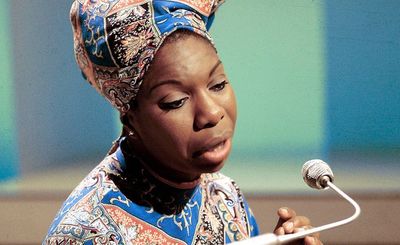By Cole Smithey
It’s a stretch to call “Mad Max: Fury Road” a Hollywood picture but we'll pretend so the left coast isn’t utterly left out of contributing to the best films of 2015, so far.
5. Ex Machina
 Science fiction has been a dying film genre in recent years. Largely this is because there are too few screenwriters or filmmakers with the imaginations to create compelling futuristic stories. Alex Garland has been an exception to the rule.
Science fiction has been a dying film genre in recent years. Largely this is because there are too few screenwriters or filmmakers with the imaginations to create compelling futuristic stories. Alex Garland has been an exception to the rule.
Smart, sexy, and back-loaded with a terrific twist ending, “Ex Machina” is an elegant sci-fi movie that considers the possibilities of artificial intelligence in thought-provoking ways. The stark narrative is essentially a three-hander for actors Domhnall Gleeson, Oscar Isaac, and Alicia Vikander to play out their diametrically opposed characters in an isolated “No Exit” game of winner-take-all.
4. Mad Max: Fury Road
 “Mad Max Fury Road” makes up for what it lacks in storyline and character development with a groundbreaking blend of feminist politics and action-movie tropes in a broad physical spectacle featuring death-defying stunts atop and between a constantly moving canvas of motor-driven insanity. “Fury Road” is to cinema as the Ramones’s “Teenage Lobotomy” was to rock ‘n’ roll. The picture’s deceptive depth lies in its blistering backbeat of fast-paced action fulfilled by a cast of gnarly Wild West-inspired characters “living to die and dying to live.” A lack of water and oil has turned humanity into hordes of people living by their primal instincts.
“Mad Max Fury Road” makes up for what it lacks in storyline and character development with a groundbreaking blend of feminist politics and action-movie tropes in a broad physical spectacle featuring death-defying stunts atop and between a constantly moving canvas of motor-driven insanity. “Fury Road” is to cinema as the Ramones’s “Teenage Lobotomy” was to rock ‘n’ roll. The picture’s deceptive depth lies in its blistering backbeat of fast-paced action fulfilled by a cast of gnarly Wild West-inspired characters “living to die and dying to live.” A lack of water and oil has turned humanity into hordes of people living by their primal instincts.
Miller proudly announces the movie as a feminist think piece. Charlize Theron’s implacable bionic-armed heroine Imperator Furiosa leads the lion’s share of the action. The steely Furiosa turns a fuel-delivery (via the giant oil truck she drives) into a rescue mission to transport five “wives” to Immortan Joe (played by Hugh Keays-Byrne in a franchise return), the demonic despot who controls the flow of water to the starving masses. The Australian filmmaker balances the motherly power of femininity with tougher aspects of womanhood, namely a cold-blooded will to kick serious ass LAMF. Instant cult classic? You bet.
3. Amy
 The must-see-documentary at this year’s Cannes Film Festival was Asif Kapadia’s ambitious biography of Amy Winehouse. It’s a devastating look at how some of the people closest to the singer/songwriter contributed to her untimely demise. By sticking with his voiceover-only narration (rather than taking the standard talking-head approach) Kapadia stays out of the way of his fascinating subject. The method is so much the better for rapt audiences to absorb Winehouse’s raw talent and sophisticated mastery of melody, songcraft, and delivery.
The must-see-documentary at this year’s Cannes Film Festival was Asif Kapadia’s ambitious biography of Amy Winehouse. It’s a devastating look at how some of the people closest to the singer/songwriter contributed to her untimely demise. By sticking with his voiceover-only narration (rather than taking the standard talking-head approach) Kapadia stays out of the way of his fascinating subject. The method is so much the better for rapt audiences to absorb Winehouse’s raw talent and sophisticated mastery of melody, songcraft, and delivery.
Most captivating are studio-recording sessions in which Winehouse delivers her unique voice and phrasing with a stark honesty that charms all. Watching her record her famous song “Back to Black” is nothing short of stunning. A duet recording session with her hero Tony Bennett reveals much about Winehouse’s craftsmanship as a singer and about the high standards to which she held herself. The instant rapport that she shares with a glowing Tony Bennett is a dreamlike moment of musical delight.
2. What Happened Miss Simone?
 Director Liz Garbus (“Bobby Fischer Against the World,” 2011) eloquently sets the film’s tone with an eerie quote from Maya Angelou.
Director Liz Garbus (“Bobby Fischer Against the World,” 2011) eloquently sets the film’s tone with an eerie quote from Maya Angelou.
“Miss Simone, you are idolized, even loved, by millions now. But what happened, Miss Simone?”
It proves to be a provocative question about a complex woman caught in a web of domestic and social abuse. Through dazzling archive performance and interview clips, and upfront contributions from the likes of Simone’s articulate daughter Lisa, Garbus hits every note in a biography that, like Nina Simone’s dynamic vocal range, goes from gravel to frosting. Intelligent audio interviews allow the outspoken singer to narrate in her own inimitable voice. Documentaries don't get much more intimate than this.
The rich narrative and musical material on display allows Garbus to work the audience into a compulsive lather of mixed emotions. The film flashes to modern day relevance over Simone’s scalding protest song “Mississippi Goddam,” a response to forty churches burned in Birmingham, Alabama.
Simone sings with a fury that explodes, “Alabama’s gotten me so upset, Tennessee made me lost my rest, And everybody knows about Mississippi Goddam.“
From a political perspective, “What Happened Miss Simone” arrives at a key moment of crisis for Blacks in America, when the ongoing incremental genocide of Blacks is on the rise.
Nina Simone’s definition of freedom rings with the same truth as is found in her music.
“What is freedom? No fear.”
1. Girlhood
 You might read the title “Girlhood” and think that some ambitious (perhaps female) filmmaker is taking on Richard Linklater at his most recent game. Indeed, if you consider Céline Sciamma’s substantial pedigree, as the masterful writer-director behind such youth-centric LGBT triumphs as “Water Lilies” and “Tomboy,” you could arrive at the conclusion that Richard Linklater has been taking some notes from her.
You might read the title “Girlhood” and think that some ambitious (perhaps female) filmmaker is taking on Richard Linklater at his most recent game. Indeed, if you consider Céline Sciamma’s substantial pedigree, as the masterful writer-director behind such youth-centric LGBT triumphs as “Water Lilies” and “Tomboy,” you could arrive at the conclusion that Richard Linklater has been taking some notes from her.
When compared to her first two tour de force films, “Girlhood” reveals itself to be every bit as insightful and authentic a cinematic representation of a personal female coming-of-age experience in modern-day France. For the record, “Girlhood” stands up well opposite Linklater’s “Boyhood” as another essential filmic chapter in the global political, socioeconomic, and cultural challenges facing young people in the 21st century, albeit from vastly different cultural backgrounds. “Girlhood” is a stunner.




